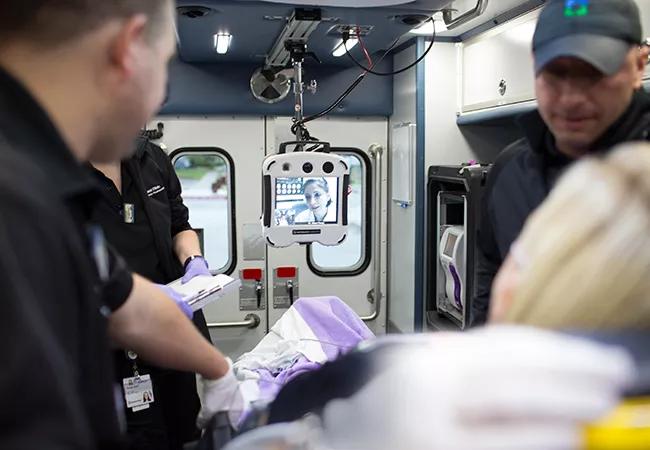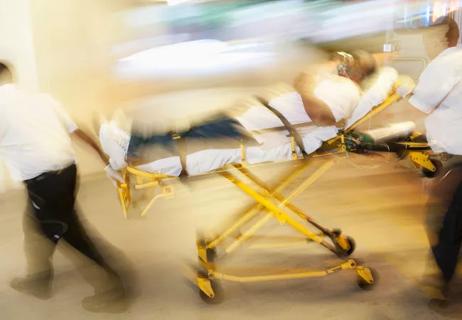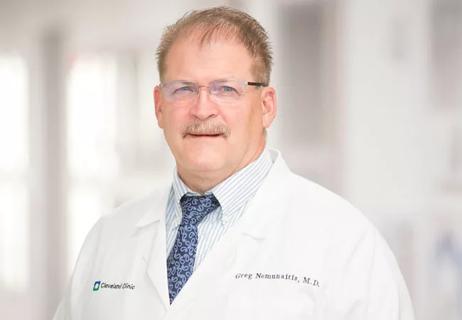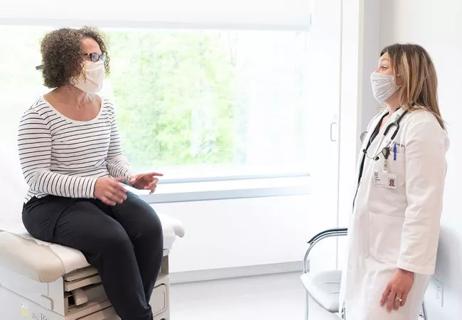Advertisement
Q&A with Dr. Andrew Russman, Medical Director of our Comprehensive Stroke Center

Research on mobile stroke units (MSUs) was among the highlights of the 2020 International Stroke Conference held in Los Angeles this past February. Andrew Russman, DO, Medical Director of Cleveland Clinic’s Comprehensive Stroke Center, was at the conference and fills us in on the latest MSU research findings and what’s on the horizon.
Advertisement
Cleveland Clinic is a non-profit academic medical center. Advertising on our site helps support our mission. We do not endorse non-Cleveland Clinic products or services. Policy
Q: Can you start with an overview of the significance of mobile stroke units?
A: Typically, when people develop stroke symptoms, they are rushed by a conventional ambulance to a hospital emergency department, where they are evaluated and triaged, given appropriate preliminary treatment, then admitted for specialized treatment such as thrombectomy, if needed, or transferred to another hospital that has that capability.
In contrast, an MSU brings the emergency room to the patient’s doorstep. All steps done in the emergency department — assessment, CT angiography, thrombolysis with tPA, transport to the most appropriate hospital — are done by the MSU. A CT is typically obtained within eight minutes of getting the patient on board; most patients would not have even arrived at the emergency department in that time if transported by any other means. You can imagine the value of this kind of efficiency for stroke, in which every minute that brain tissue is deprived of blood flow leads to a loss of 1.9 million neurons.
Q: What are some of the important investigations being done involving MSUs?
A: Results of the German B_PROUD (Berlin Prehospital Or Usual Delivery) study were presented at the International Stroke Conference in February 2020. This prospective randomized trial compared 654 patients with acute ischemic stroke transported via MSU with 683 patients transported by standard ambulance. MSU transport was associated with a higher rate of thrombolysis (60% vs. 48%) and reduced time to tPA (50 vs. 70 minutes). Most importantly, patients transported by MSU had improved functional outcomes after three months, as measured by the modified Rankin scale, with a higher likelihood of being functionally independent.
Advertisement
Cleveland Clinic’s experience supports the B_PROUD findings. As reported in a nonrandomized study presented at the 2019 International Stroke Conference, we compared 143 patients transported by our MSU with 196 patients transported by standard ambulance to a Cleveland Clinic hospital. We found the MSU to be associated with faster interventions and doubling of the likelihood that patients would have excellent or good functional outcomes.
Another Cleveland Clinic study, recently published in Frontiers in Neurology, found that MSUs can be a cost-effective strategy. That’s a big issue, considering that the initial outlay and annual operating costs for an MSU can be daunting for a health system. Savings are realized when certain thresholds are reached, including the number of stroke patients served and the likelihood that patients require transfer to a Comprehensive Stroke Center.
Q: What’s next in MSU research?
A: Until now, MSU research has focused mainly on ischemic strokes, which account about 90% of strokes at most institutions. Because Cleveland Clinic is a Comprehensive Stroke Center, about 30% of the strokes we treat are actually hemorrhagic, which uniquely allows us to assess the role of MSUs for this type of stroke.
Our MSU can take a variety of actions for patients diagnosed with hemorrhagic stroke: blood pressure can be controlled, the rapid reversal agent Kcentra® can be given for patients taking warfarin, and patients on a direct oral anticoagulant can be transported directly to an emergency room that has countermeasures available.
For all these actions, just like for ischemic stroke, we expect that research will demonstrate that by using MSUs to help slow the expansion of a bleed in a timelier manner, functional outcomes should improve. Stroke clinicians can be on the lookout for results from at least two national studies of hemorrhagic stroke:
If these measures prove effective, MSUs can likely play an important role in improving efficiency by either allowing therapy administration onboard or transporting patients to appropriate care faster.
Q: This interview wasn’t meant to discuss the COVID-19 pandemic, but it’s on everyone’s mind. Is there anything you’d like to mention about it?
Advertisement
A: One interesting note is that MSUs depend highly on telemedicine technology, and its use was largely pioneered and advanced through distance acute stroke diagnosis and management. “Telestroke” uses interactive videoconferencing between the crew on the MSU and stroke neurologists at the hospital who provide remote guidance. During this pandemic, telehealth technologies are rapidly being deployed for many specialties to help patients access remote care and avoid unnecessary emergency department and clinic visits. So in this sense stroke care helped pave the way for the current explosion in telehealth adoption.
Advertisement
Advertisement

Analysis characterizes geography’s sizable role in urban/rural care divides

New analysis details the disparities and points to opportunities for improvement

In survey, both female and male respondents reporting ongoing concerns

Group advocates for stroke systems of care supported by telestroke and proper reimbursement

Dr. Gregory Nemunaitis looks to build on his history of integrating education, research and patient care

Mission centers on screening, prevention for at-risk women in their 30s to 60s

One-year results from national database confirm enduring benefits

From B-PROUD to EXTEND-IA TNK to a novel TMS delivery method